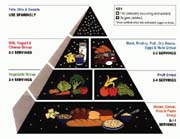Authors' note: In 2000, USDA began a multi-year, comprehensive reassessment to update the Food Guide Pyramid, which is scheduled for release in 2005 along with the revised Dietary Guidelines for Americans. The purpose for updating the pyramid is two-fold. First, an update ensures that dietary recommendations for types and amounts of food to eat daily continue to meet current nutritional standards; and second, consumers can understand and apply the pyramid's message. The National Dairy Council actively supports USDA's efforts to update the Food Guide Pyramid.
The Dietary Guidelines for Americans, first released in 1980 and revised most recently in 2000, are the basis for federal nutrition policy. The policy affects nutrition assistance programs including the National School Lunch Program (NSLP) and the School Breakfast Program (SBP), as well as other government feeding and nutrition education programs. With the passage of the Healthy Meals for Healthy Americans Act in 1994, the NSLP and SBP must now meet the nutritional standards of the Dietary Guidelines for Americans (e.g. provide no more than 30% of calories from fat and less than 10% of calories from saturated fat).
So how do the dietary guidelines and food pyramid affect each other? For starters, the dietary guidelines are updated every five years in order to be consistent with the most current science related to diet and health. The Food Guide Pyramid is an educational tool based on the dietary guidelines. It translates nutrition recommendations from the dietary guidelines and the Dietary Reference Intakes for individual nutrients into the kinds and amounts of food to eat each day for a healthful diet.

Pyramid power
The current dietary guidelines encourage consumers to "Let the Pyramid guide your food choices" by choosing the recommended number of daily servings from each of the five major food groups, one of which is "Milk, Yogurt & Cheese," or simply dairy.The food pyramid communicates two unique features of dairy, both of which positively influence public perception of dairy products, thus enhancing dairy consumption. First, dairy enjoys a position in the food pyramid as a distinct food group. Second, the pyramid communicates that dairy is one of five major food groups and that everyone needs to get the recommended servings daily to meet nutritional needs. This has greatly reinforced dairy's position in federal nutrition programs and has influenced the requirement for dairy products in virtually all U.S. government-feeding programs. Currently, milk is the only specified food that must be offered as part of all reimbursable school lunches and breakfasts. It is estimated that 3,115 million lbs of milk were sold through public schools in the 2001-2002 school year, or about 5.8% of total U.S. beverage milk sales in 2001.
You can see why it is important to farmers that dairy be a part of the food pyramid. However, making farmers happy is not why dairy foods have such a prominent position in the food pyramid, as well as in the dietary guidelines. Dairy foods are a cornerstone of the dietary recommendations made to Americans as a result of overwhelming scientific agreement about the nutritional value of consuming the recommended number of servings of milk, cheese and yogurt. Dairy foods are rich sources of calcium and contain eight other essential nutrients required for growth and development.
Reassessment means getting it right
It is important for the health of consumers, as well as the industry, to ensure that the current reassessment of the Food Guide Pyramid is based on the best and most current science available. Dairy is currently at a critical crossroads for maintaining its unique position. For example, health professionals continue to suggest low-fat alternatives in dietary guidance for reducing risk of heart disease. Recently, however, new data indicate that individuals consuming diets with increasing amounts of dairy from less than one serving to greater than five servings per day did not cause blood cholesterol levels to increase despite their diets being higher in fat and saturated fat.Other products with the potential to erode dairy's position on the food pyramid include competitive non-dairy ingredients and calcium-fortified non-dairy beverages and foods. Case in point is the current dietary guidelines, which count one cup of soy-based beverage with added calcium as an alternative non-dairy serving of calcium, and, despite the highly variable calcium levels in soy beverages, equates its calcium content to the amount contained in one serving of milk, cheese or yogurt. Studies have shown that the calcium is less bioavailable from soy compared to dairy. Also, tofu made with calcium sulfate, cereal with added calcium and fruit juice with added calcium are identified as alternative good sources of calcium. But it is important to keep in mind that dairy delivers other essential nutrients than just calcium.
In an effort to determine the impact of non-dairy sources of calcium on health outcomes, the advisory committee also recommended studies to determine the impact of substituting high-calcium non-dairy foods for high-calcium dairy foods on nutrient status and bone health. In a recent study that reassessed the Food Guide Pyramid's guidance for calcium, USDA scientists concluded that substituting calcium-fortified orange juices or other non-dairy foods for all milk group servings is not recommended. The other nutrients usually provided by the dairy group must be considered when recommending dietary patterns to meet nutritional standards.
Finally, dairy's position is always challenged by special interest groups that advocate positions inconsistent with the dairy's nutritional stance (e.g. vegans, animal rights groups, etc.), as well as from groups promoting alternative food guidance "pyramids," which may recommend fewer servings of dairy foods.
Clearly, dairy's greatest strength is a heritage of emphasizing the need for sound science to drive public health and food guidance policy. Dairy needs to marshal the best scientific data to show the health benefits of dairy because failure to do so can result in diminished prominence in the food pyramid, reduced scientific/health professional endorsement, less prominence in schools (i.e. NSLP, SBP), loss of competitive marketing advantages and reduced consumer confidence.

Science is stronger than ever
A substantial body of sound science underpins dairy's position in the food pyramid, documenting the contribution dairy foods make to a healthful diet.Dairy foods are the major-and most abundant-natural source of calcium in the U.S. diet. In fact, dairy foods contribute 72% of the calcium available in the nation's food supply. In an analysis of food sources of calcium, milk and milk products provided 83% of the calcium in the diets of young children, 77% in adolescent female diets, and 65% to 72% in adult diets. You can see how important it is to consume dairy products in order to meet dietary calcium recommendations.
In addition to calcium, dairy foods contribute substantial amounts of other essential nutrients including protein, phosphorus, potassium, riboflavin, magnesium, zinc and vitamins A, B12, and D. Milk, cheese and yogurt provide a unique nutrient-rich package that studies show improve the overall nutritional quality of the diet and offers other health benefits including improving bone health, reducing high-blood pressure and managing body weight.
Currently the food pyramid recommends two-to-three servings of dairy foods per day; however, research sponsored by America's dairy farmers using the most recent (1997) values for the Dietary Reference Intakes for calcium and the most recent government data on calcium intakes, shows that at least three daily servings of dairy are needed for the majority of the populations to meet current calcium recommendations-and four servings for other groups such as children ages nine- to 18-years old during their peak bone-building years.
A growing body of literature also indicates that three-to-four servings of dairy foods per day helps lower the risk of chronic disease conditions other than bone health. For example, research suggests that dairy foods play a role in lowering blood pressure, as well as reducing the risk of obesity.
In conclusion, the current updating of the Food Guide Pyramid, which is set to be released in coordination with the 2005 Dietary Guidelines for Americans, is meant to ensure that the types and amounts of foods recommended for a healthful diet continue to meet nutritional standards and that consumers can understand and apply its messages. These are goals that the National Dairy Council fully support and have actively provided input on issues and opportunities for dairy.
The National Dairy Council is not only providing data on why dairy foods are critical to the structure of the pyramid, but also why the recommended servings per day should increase.
To learn more about the Food Guide Pyramid and the Dietary Guidelines for Americans, visit www.usda.gov/cnpp/. Additional resources are available at www.nationaldairycouncil.org. Or, for more information, call the National Dairy Council Media Hotline at 312/240-2880.
